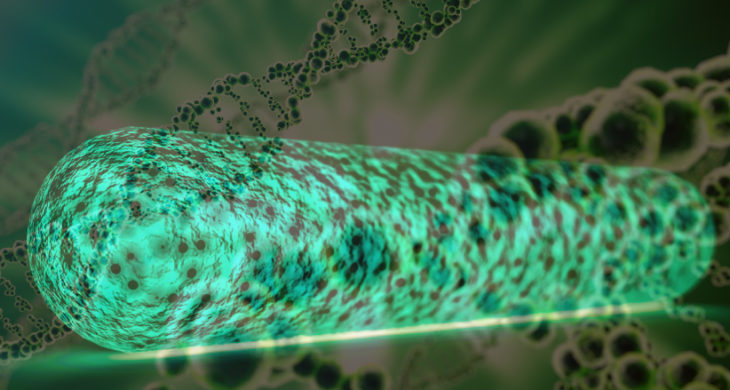
Date: 25th March 2022
The microbiome is the collection of all microbes that naturally live in and on our bodies. They are a key interface between the body and the environment, and play many functional roles in human healthy, leading to the interest in using live bacteria to treat disease. Easily engineered, these intelligent living medicines can sense and respond to environments, and deliver local therapeutics. However, immunogenicity and toxicity in hosts have limited their use in the clinic. Now, researchers have developed a genetically encoded microbial encapsulation system with tuneable and dynamic expression of surface capsular polysaccharides that enhanced systemic delivery and temporarily evaded the immune system, enabling a ten-fold increase in tolerated doses of bacteria and improved anti-tumour efficacy.
In contrast to conventional drug carriers, bacteria-based vessels can continuously proliferate, translocate and deliver therapeutic payloads in cancer tissue, facilitating robust and temporal control of bacteria pharmacokinetics in vivo. However, they can be recognised by the body’s immune systems as foreign, causing high inflammatory responses leading to high toxicity or rapid bacteria elimination, conversely too little bacteria results in no therapeutic effects. Finding the balance between the two is challenging, and several clinical trials have had to be terminated due to severe toxicity.
Now, researchers at Columbia University, US, led by Tal Danino and Kam Leong have programmed bacteria with an on/off switch for the immune system, using circuits that control the bacteria surface, creating a molecular ‘cloak’ that encapsulated the bacteria. The bacteria were also engineered to produce an antitumour toxin, and were able to shrink tumour growth in colorectal and breast cancer in mice.
To create the on/off switch the team focused on capsular polysaccharides (CAP), which are sugar polymers that coat bacteria surfaces and help them evade the immune system, without CAP encapsulation protection is lost and the bacteria can be cleared out of the body. Biohijacking the CAP system, they built it into an on/off switch engineering it into an inducible version, called iCAP, under the control of an external molecule IPTG. This allowed for programmable and dynamic alteration of the bacteria E. coli cell’s surface (here they used a probiotic strain, E. coli Nissle 1917 (EcN), which has favourable clinical profiles), controlling how the immune system responded to the therapeutic bacteria.
They first tested the ability to control bacterial viability in human whole blood containing functional host bactericidal factors in vitro. Upon IPTG induction, the team observed increased EcN iCAP survival compared to uninduced controls, when the inducer was removed, iCAP deactivation occurred, allowing the clearance of bacteria. Moreover, modulation of the rate of bacterial clearance could be achieved by titrating levels of IPTG. Whilst wild type EcN cleared in more than 6 hours, the iCAP version decreased rapidly in as little as 30 mins when IPTG was removed. In the absence of CAP the bacteria increased levels of many inflammatory cytokines whereas activated EcN iCAP was able to decrease inflammatory responses. Together, suggesting the CAP could mask microbial recognition from the immune system and that the programmable CAP system had the potential to modulate a multitude of host-microbe interactions and could be translated to in vivo use.
Next the team wanted to test the protective function of CAP in vivo. Delivery into the blood of mice showed that control unencapsulated bacteria were quickly eliminated whereas the wildtype version (containing a CAP) was detected for up to four hours, and was accompanied by lower levels of acute inflammatory cytokines. The inducible version, EcN iCAP, preinduced prior to administration, generally induced less inflammatory response than unecapsulated bacteria, supporting successful encapsulation in vivo. Furthermore, administration of escalating doses of the variants of EcN bacteria showed a notable reduction in toxicity with EcN iCAP. In sepsis experiments the team observed consistent improved safety for EcN iCAP, and in biodistribution studies ~10-fold less EcN and EcN iCAP were found in peripheral organs that unencapsulated bacteria. Together, these suggested that transient CAP improved engineered probiotic therapy in vivo.
Finally, the team wanted to tested whether the programmable CAP system could improve anti-tumour efficacy by permitting higher doses. So they engineered EcN iCAP to deliver anti-tumour payloads - the theta toxin (TT) gene encoding a pore-forming toxin. In colorectal tumour-bearing mice they found significantly higher signals in tumours compared to all other groups treated with the variants of EcN bacteria. Low-dose EcN iCAP exhibited modest tumour growth suppression compared to the untreated group over 14 day however, administered at its maximum tolerated dose (MTD) EcN iCAP managed to elicit significant tumour growth suppression by ~400% compared to the untreated group. The treatment also resulted in improved tumour growth suppression by ~100% compared to the unencapsulated EcN over 14 days in a mouse model of breast cancer.
These data suggested that the iCAP system enabled increased tolerable bacterial doses and improved therapeutic efficacy at the primary tumour site, but could the system work for distal tumours? To answer this the team used the unique capability of intratumoural (i.t) injection – which allows for the translocation of bacteria from injected tumours to distal tumours. Here they injected one tumour with the un-induced EcN iCAP, then subsequently fed the mice IPTG. Upon activation they found a marked increase in bacterial translocation to multiple distal tumours throughout the body. In contrast, the bacteria remained in the injection tumour if IPTG was not given.
Conclusions and future applications
The team here have demonstrated a synthetic biology approach for dynamic and tuneable modulation of the bacterial surface in the context of in vivo therapeutic delivery. The iCAP system enhanced systemic delivery of therapeutic bacteria by transiently encapsulating bacteria allowing immune evasion, it reduced initial inflammation while effectively clearing bacteria over time. Engineered with an antitumour toxin the iCAP system controlled bacterial translocation between tumours, resulting in bacteria migration to untreated tumours at multiple locations arounds the body.
The group will now explore a range of research areas for the iCAP system, with more than 80 different types of CAP for just E.coli, expanding the work to other CAPs, other species, and to other surface molecules is a daunting task but will likely reveal new methods of controlling bacteria for therapeutic use, and overcome the current challenges. In addition, they will be investigating other way to control iCAP such as biosensors which could be used autonomously to control the surface properties.
Dose-limiting toxicity has been a long-standing challenge, slowing efforts for clinical translation. One such hurdle yet to be overcome is iCAPs safety in humans. However, given humans are 250-fold more sensitive to endotoxins than mice, the team expect their results to have implications in the clinical translation of bacterial therapies.
Evading the immune system is key for many therapies, and cloaking devices for therapeutics is not a new idea. We have recently seen safer cloaked gene therapy tools, where scientists have engineering cloaked adeno-associated virus (AAVs) to evade innate immune and inflammatory responses by incorporating short DNA oligonucleotides that antagonise immune cell receptors. Others have used compound targeted mutagenesis to minimise virus interactions with blood factors, creating a ‘stealth bomber’ virus that can suppress tumour growth and prolong survival without inducing hepatotoxicity, and can target metastatic cancer. However, the advantage of the iCAP system is programmable control of the therapeutic bacteria, where evading the immune system is equally as important as being able to switch it off. Here, the programmable encapsulation system promises to enhance the therapeutic utility of living engineered bacteria for cancer and has the potential to be extended to other clinical settings.
For more information please see the press release at Columbia University
Harimoto, T., Hahn, J., Chen, Y.-Y., Im, J., Zhang, J., Hou, N., Li, F., Coker, C., Gray, K., Harr, N., et al. (2022). A programmable encapsulation system improves delivery of therapeutic bacteria in mice. Nature Biotechnology.
https://doi.org/10.1038/s41587-022-01244-y
http://eha.3a7.mywebsitetransfer.com/safer-cloaked-gene-therapy-tools-evade-immune-system/
http://eha.3a7.mywebsitetransfer.com/stealth-bomber-virus-evades-immunity-target-metastatic-cancer/

